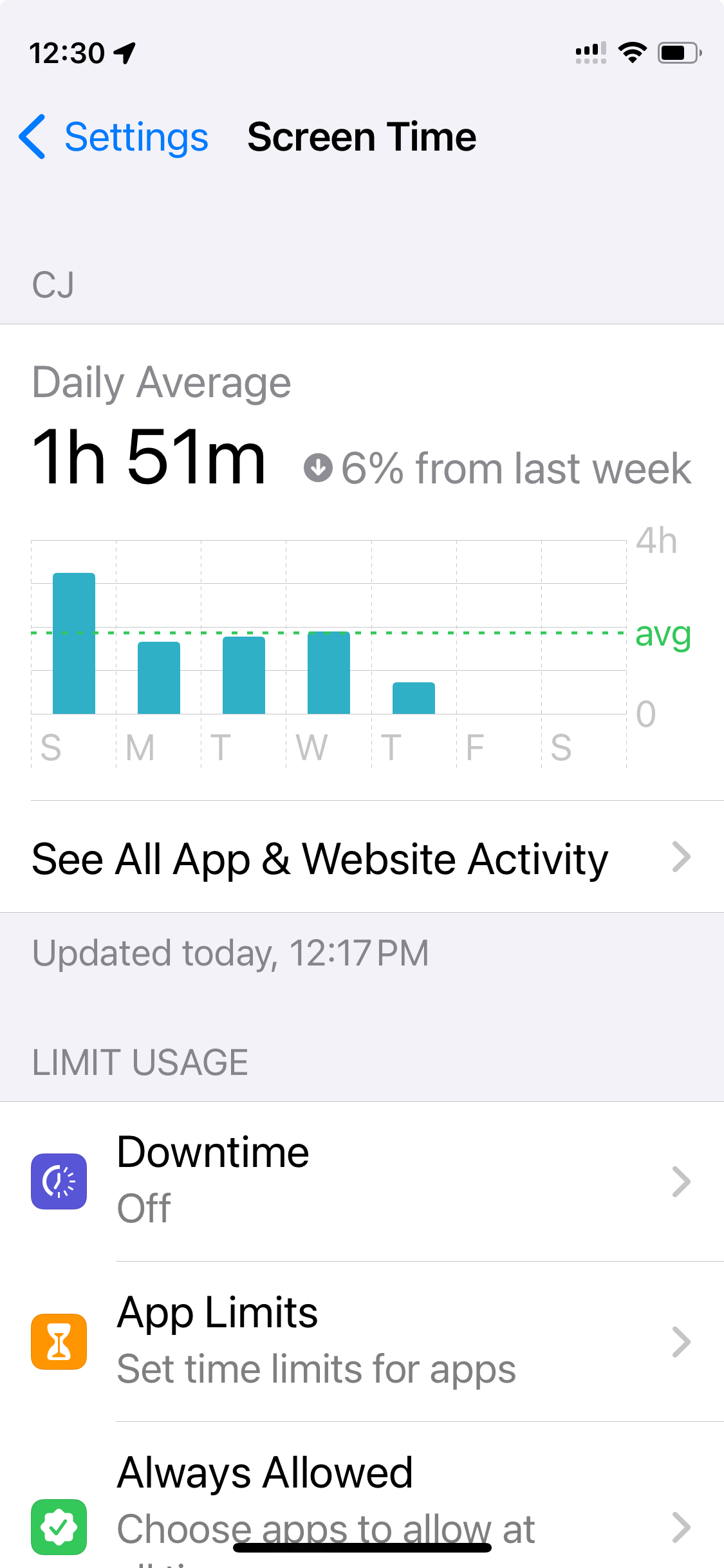 In a world where the average American glances at their phone every few minutes, tallying up to an astonishing 3 hours and 30 minutes of screen time daily, our digital habits are silently sculpting our lives. With each pickup, swipe, and click, we’re not just passing the time; we’re shaping our day-to-day experiences and, inadvertently, our values. But how often do we pause to consider if the way we spend our time truly aligns with our personal values? Inspired by Jay Shetty’s transformative approach in “Think Like a Monk,” let’s create a path to mindful living, where every minute counts towards crafting a life filled with purpose, presence, and profound personal fulfillment.
In a world where the average American glances at their phone every few minutes, tallying up to an astonishing 3 hours and 30 minutes of screen time daily, our digital habits are silently sculpting our lives. With each pickup, swipe, and click, we’re not just passing the time; we’re shaping our day-to-day experiences and, inadvertently, our values. But how often do we pause to consider if the way we spend our time truly aligns with our personal values? Inspired by Jay Shetty’s transformative approach in “Think Like a Monk,” let’s create a path to mindful living, where every minute counts towards crafting a life filled with purpose, presence, and profound personal fulfillment.
Recent studies on screen time usage and phone interactions have revealed significant insights into our digital habits. In 2023, the average American spent approximately 7 hours and 4 minutes per day on screens, encompassing a range of devices, including phones, computers, and others. Specifically, daily phone usage averaged 3 hours and 30 (The Tech Report, 2023) and the average person picks up their phone 58 times per day.
Social media platforms, particularly TikTok, have substantially contributed to this screen time allocation. In the United States, TikTok was the most utilized app in 2023, with an average daily usage of 55.8 minutes. It also led globally as the most-used social media app, with users dedicating approximately 23.5 hours per month to it. YouTube and Facebook followed closely, with users spending 23.1 and 19.7 hours per month on these platforms, respectively (Windows Report, 2023).
A notable statistic is the frequency at which Americans check their smartphones—on average, every 4 minutes. Moreover, Pew Research data indicates that 31% of Americans are almost constantly online, with another 48% accessing the internet several times a day (Windows Report, 2023).
Time Management and Personal Values
In his book, “Think Like a Monk”, Jay Shetty emphasizes the importance of living a life aligned with one’s values. He suggests that to achieve this, one must first identify those values. Whether it’s family, education, or a particular hobby, recognizing these values is the first step toward mindful living. However, recognizing our values is only part of the equation; the other, often more challenging part, is aligning our time and actions with these values.
Conducting a Time Audit
A time audit involves tracking how you spend your time over a day or a week. This can be an eye-opening exercise, revealing how much of our time is spent on activities that do not contribute to our core values.
To conduct a time audit, you can use a simple notebook or a time-tracking app to record all your activities throughout the day. The key is to be honest and detailed, noting everything from when you wake up to when you go to bed.
Aligning Time with Values
Once you have a clear picture of where your time goes, the next step is to evaluate how well your activities align with your values. This might require some tough introspection. Finding a discrepancy between your values and how you spend your time indicates that some changes are needed.
This could mean:
Cutting down on activities that do not serve your values, like mindless scrolling on social media.
Introducing new habits or routines that better reflect your core values, such as dedicating time to family or personal development.
Addressing Misalignments
Identifying misalignments between your values and how you spend your time is crucial. It may reveal habits that are interfering with your goals, a need to re-evaluate your current life goals, or simply that you need to make the time for what truly matters. Addressing these misalignments often involves setting new priorities, making lifestyle changes, and sometimes, using tools to help manage distractions, like phone usage.
Tools and Tips for Reducing Screen Time
Given the significant impact of phone addiction on our time and attention, employing tools and strategies to manage this is essential. Apps like “Opal” can help by blocking access to distracting websites and apps, retraining our habits around phone use. Furthermore, most smartphones now come with built-in tools to monitor screen time usage, allowing users to set limits for certain apps or activities.
Commitments to Reduce Screen Time
- Making concrete commitments can further reduce screen time and align your daily life with your values. Simple commitments might include:
- No phones at meal times, commit to fostering relationships with those around you or focus on mindfully eating.
- Avoiding phone use in the first and last 30 minutes of your day to improve sleep and start your day more mindfully.
- Using moments like waiting in line or red lights to practice mindfulness or reflect on your day rather than checking your phone.
By consciously deciding where and how we spend our time, especially in relation to our phone usage, we can take significant strides towards living a life that is not only more purposeful but also more aligned with our personal values.
Reflecting on Jay Shetty’s advice, it’s clear that managing phone addiction and aligning our time with our values are not just about discipline; they’re about making intentional choices that foster a life filled with purpose and fulfillment. As we work towards these goals, let’s remember that every small change in how we manage our time and attention can lead to significant improvements in our overall quality of life.
To manage screen time and understand your digital habits better, both iPhone and Android devices offer built-in features that track screen time usage and the number of times the phone has been picked up. Here’s how you can find this information on both types of devices:
- Access Screen Time: Go to “Settings” and tap on “Screen Time.” If you haven’t already, you might need to turn on Screen Time by following the on-screen instructions.
- View Report: Once Screen Time is enabled, you can view your daily or weekly usage report, which shows how much time you’ve spent on your device and specific apps.
- Pickups: The Screen Time report also includes information on the number of times you’ve picked up your iPhone each day and which apps you used first after picking up your device.
- Set App Limits: You can set daily limits for app categories you want to manage closely to help reduce your screen time.
- Downtime: Schedule downtime for yourself, during which only phone calls and apps that you choose to allow will be available.
For more detailed instructions and tips on using Screen Time on an iPhone, you can visit Apple’s official support page at: https://support.apple.com/en-us/HT208982.
On an Android Device:
- Digital Wellbeing & Parental Controls: Open “Settings” and look for “Digital Wellbeing & Parental Controls.” Depending on your device’s manufacturer and Android version, this feature might be located under different names or settings menus.
- Dashboard: Within Digital Wellbeing, you’ll find a dashboard that displays your screen time, the number of notifications you’ve received, and how many times you’ve unlocked your device.
- App Timers: Similar to iPhone’s App Limits, you can set timers for individual apps to help manage your usage.
- Focus Mode: This feature allows you to pause distracting apps to help you focus temporarily.
- Bedtime Mode: Customize your device’s settings to help you wind down at night, such as turning the screen to grayscale or silencing notifications.
For more specific guidance tailored to your Android device’s model and operating system version, you can visit Google’s Digital Wellbeing guide at: https://wellbeing.google/.
By regularly checking your screen time statistics and making conscious adjustments, you can take significant steps towards managing your digital well-being and ensuring that your technology use aligns with your personal values and lifestyle goals.
Let’s remember that our time is the canvas of our lives, and every moment we spend glued to screens is a stroke of color on that canvas. The statistics are clear: with an average of 3 hours and 30 minutes daily spent on phones and countless pickups, our digital habits are more than just routines; they are reflections of what we prioritize. But armed with awareness and the transformative advice from Jay Shetty in “Think Like a Monk,” we have the power to audit our time and realign our actions with our deepest values.
Let this not be an end but a beginning—a starting point to a more mindful, purposeful existence where each second counts not in likes and shares, but in meaningful connections, learning, and growth. As you move forward, challenge yourself not just to reduce screen time, but to fill the reclaimed time with what truly matters to you. May your days be rich with purpose, your moments filled with presence, and your life a testament to the values you hold dear.
In this era of endless distractions, let us not forget: we are not merely users of technology but masters of our own time. Here’s to living a life where every minute is spent not by habit but by choice—a life that truly reflects who we are and aspire to be.
References:
The Tech Report. (2023). 50+ Screen Time Statistics and Facts in 2023. [online] Available at: https://techreport.com
Windows Report. (2023). Screen Time Statistics for 2023 & Over the Years [All Countries]. [online] Available at: https://windowsreport.com
Carrie. J. Graves, DAcCHM (Candidate), Dipl. Ac. & C.H., L.Ac, B.S., AOBTA-C.P.



